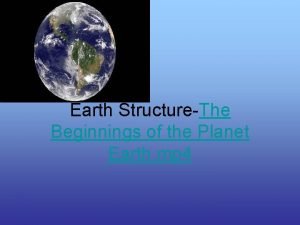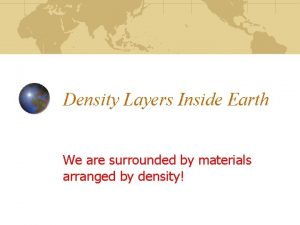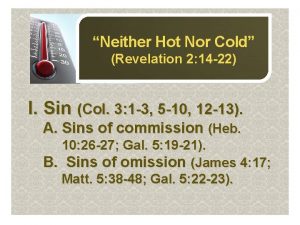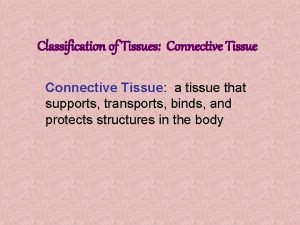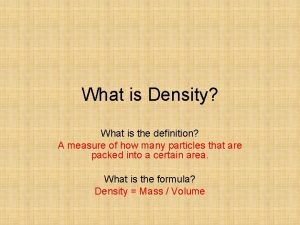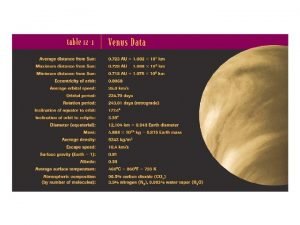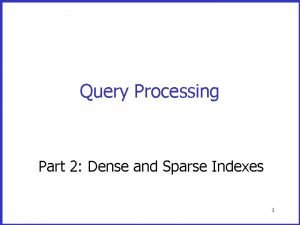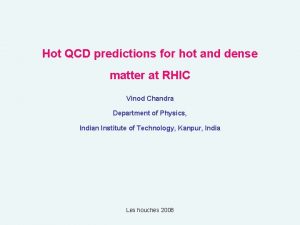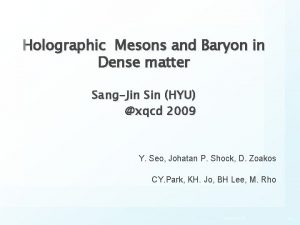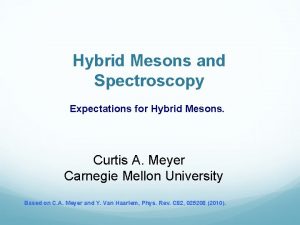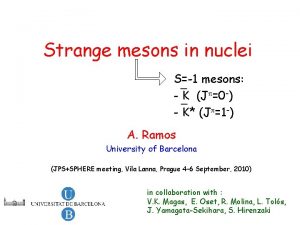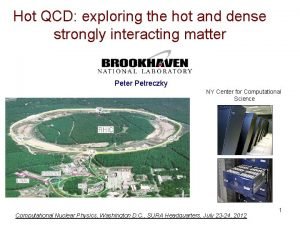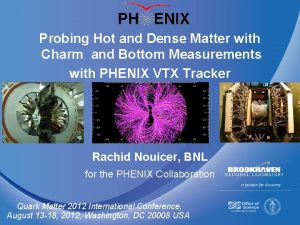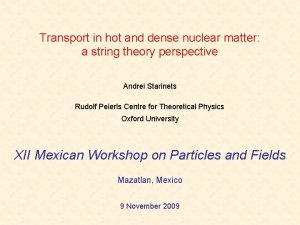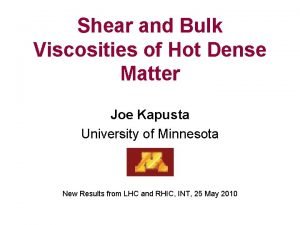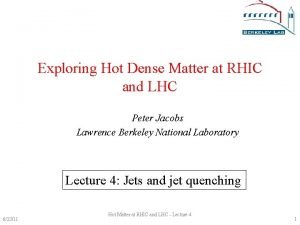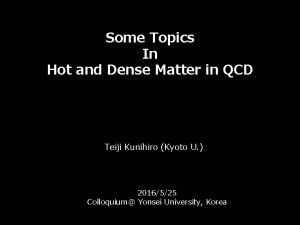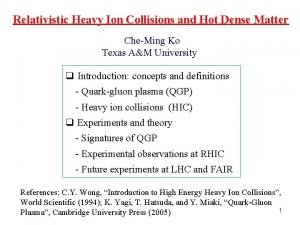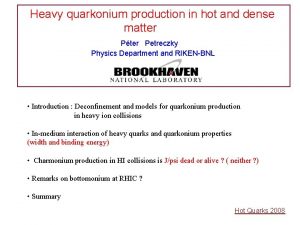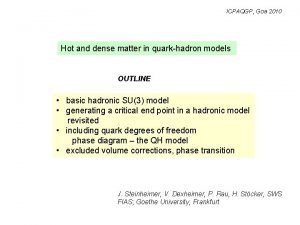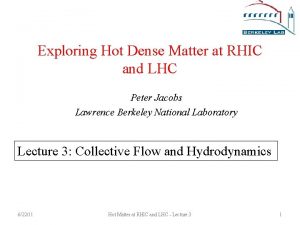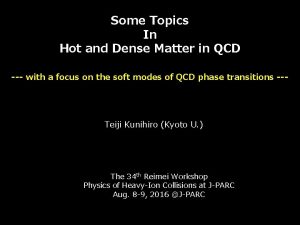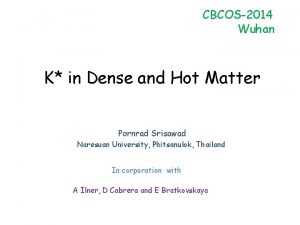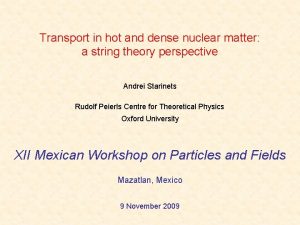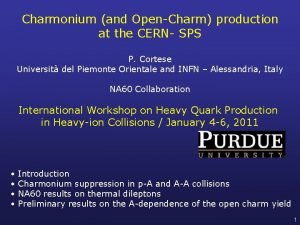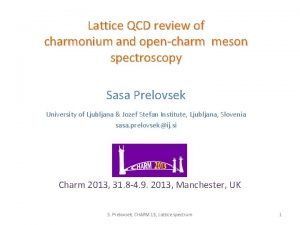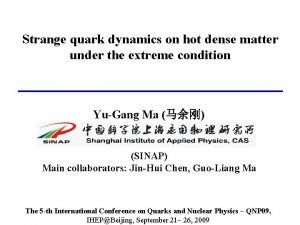Opencharm mesons in hot and dense matter L










![Free space DN amplitudes I=0 I=1 R. Mizuk et al. [Belle Collaboration] Phys. Rev. Free space DN amplitudes I=0 I=1 R. Mizuk et al. [Belle Collaboration] Phys. Rev.](https://slidetodoc.com/presentation_image/d6ff19bdd71587150f3e7ab5e25cc336/image-11.jpg)











- Slides: 22

Open-charm mesons in hot and dense matter L. Tolos 1, A. Ramos 2 and T. M. 3 1 FIAS (University of Frankfurt) 2 Universitat de Barcelona 3 Virginia Tech 1. Motivation 2. Self-consistent coupled-channel approach: Charmed baryon Resonances: c(2593) and c(2800) 3. Open-charm mesons in hot dense matter 4. Conclusions & Outlook Jefferson Lab, May 20 2008

Motivation Experimental scenarios. . • J/ suppression NA 50 Collaboration, M. Gonin et al. , NPA 610 (1996) 404 c initially predicted by color screening in QGP T. Matsui and H. Satz, PLB 178 (1986) 416 but also due to comover scattering _ several authors: A. Capella, R. Vogt, X. N. Wang, W. Cassing, O. Linnyk, A. Andronic. . J/ + , D + D • Open-charm enhancement NA 50 Collaboration, M. C. Abreu et al. , EPJ C 14 (2000) 443 but recent debate because of dimuon production by NA 60 Collaboration, E. Scomparin, talk @ QM 2005 • D-mesic nuclei - predicted by QMC model for D-, D 0 & D 0 in 208 Pb K. Tsushima et al. PRC 59 (1999) 2824

CBM@FAIR To understand these issues it is imperative to have a realistic picture of the properties of charmonia and open charm mesons in a hot nuclear environment. This is especially important for the conditions of the CBM@FAIR heavy ion experiment, where both density ( ~1 -2 fm-3) and temperature (T~100 Me. V) are relevant parameters.

From theoretical side. . _ DN interaction: similar features as KN interaction. In the charm sector we also find a subthreshold I=0 resonance, the c(2593) (udc) with a strong resemblance to the (1405) (uds). May the c(2593) be generated also dynamically?

• Predictions for the mass shift in mean-field models: UD+( 0) ~ -60 to -200 Me. V and UD-( 0) ~ 20 to -140 Me. V § QMC model K. Tsushima et al. PRC 59 (1999) 2824, A. Sibirtsev et al. EPJ 6 (1999) 351 § QCD sum-rule model A. Hayashigaki PLB 487 (2000) 96, 2 W. Weise Hirschegg’ 01 (2001) 249 § Chiral model A. Mishra et al. PRC 69 (2004) 015202 • Spectral function in self-consistent coupled-channel approach: § D meson self-energy with a SU(3) separable potential for u-, d- and ccontent as bare interaction LT, J. Schaffner-Bielich and A. Mishra PRC 70 (2004) 025203; LT, J. Schaffner-Bielich and H. Stoecker PLB 635 (2006) 85 (finite T!) _ § D and D meson self-energy with an improved bare interaction by extension to SU(4) M. F. M. Lutz and C. L. Korpa PLB 633 (2006) 43 § D meson self-energy using a revised SU(4) interaction + scalar-isoscalar attractive DN term T. Mizutani and A. Ramos PRC 74 (2006) 065201 _ HERE: we extend the model to D mesons and implement finite T effects




Self-consistent coupled-channel approach: c(2593) and c(2800) Model: 1. Potential V built from the meson-baryon Lagrangian at lowest order V SU(4) symmetry broken by the use of physical masses.

V is also supplemented by a scalar-isoscalar interaction ( DN term) (from QCDSR) 2. Unitarization: N/D method à equivalent to Bethe-Salpeter coupled-channel equations with on-shell amplitudes = Tij = + Vij + Vil Gl. Tlj The loop function G is regularized with a cut-off [adjusted to reproduce c(2593)] Model A: Model B:
![Free space DN amplitudes I0 I1 R Mizuk et al Belle Collaboration Phys Rev Free space DN amplitudes I=0 I=1 R. Mizuk et al. [Belle Collaboration] Phys. Rev.](https://slidetodoc.com/presentation_image/d6ff19bdd71587150f3e7ab5e25cc336/image-11.jpg)
Free space DN amplitudes I=0 I=1 R. Mizuk et al. [Belle Collaboration] Phys. Rev. Lett. 94, 122002(2005) Sc(2800), G~60 Me. V The model generates the I=0 c(2593) and another resonance in I=1 around the nominal c(2800)!

In-medium DN interaction: selfconsistent coupled-channel procedure = Free space Tij = + Vij + = Medium Tij( ) = Dressed D meson: Vil Gl. Tlj + Vij + = Vil Gl( ) Tlj( ) + meson dressing Pauli blocking and baryon dressing

Medium modifications at finite temperature in the intermediate propagator G( , T) 1. Pauli blocking for nucleons: 2. Properties of mesons and baryons in the medium: - model at finite temperature for baryons (N, , , c, c) self-energy at finite temperature

_ Self-consistent calculation for D and D self-energy ~ where T is the in-medium interaction_at finite temperature and P=q+p is the 4 -momentum _ of the D(D)N pair in the nuclear matter rest frame. Then, the D(D)N propagator and the spectral density read

Open-charm mesons in hot dense matter In-medium c(2593) & c(2800) at finite temperature

D meson spectral function at finite temperature c*N-1 qp peak c*N-1

Evolution with density and temperature of the D spectral function Similar trend to previous finite temperature results LT, J. Schaffner-Bielich and H. Stoecker PLB 635 (2006) 85

_ DN _ scattering lengths & D meson potential in contrast with LK similar to LK but half of HKMS LK: M. F. M. Lutz and C. L. Korpa, PLB 633 (2006) 43 HKMS: J. Haidenbauer et al. , EPJA 33 (2007) 107

_ D and D meson potentials


Conclusions & Outlook We perform a_self-consistent coupled-channel calculation of the D and D self-energies in symmetric nuclear matter at finite temperature taking, as bare interaction, the SU(4) TW contribution supplemented by DN term üIn hot dense matter, c(2593) and c(2800) stay close to their free position but develop a remarkable width. üThe D meson spectral density shows a single pronounced peak at finite temperature that melts with increasing density. üThe low-density approximation NOT a good one for the bar DN, where the repulsive I=1 component dominates. ü Temperature induces a stronger change in the mass of _ D than D meson and different behaviour of the imaginary part due to distinct resonant structure.

Open questions? ØJ/ suppression Ø Open-charm enhancement Ø D-mesic nuclei Some answers expected at CBM @ FAIR Working along these lines… • Dressed charmed baryons beyond mean-field • In-medium charmed cross sections • …. Laura Tolos, A. Ramos and T. M. ar. Xiv: 0710:
 Crust outer core inner core mantle
Crust outer core inner core mantle Earth's layers most dense to least dense
Earth's layers most dense to least dense The earth's layers foldable
The earth's layers foldable Koosha golmohammadi
Koosha golmohammadi Median and lateral apertures
Median and lateral apertures Gray matter and white matter
Gray matter and white matter White matter vs grey matter
White matter vs grey matter White hot vs red hot temperature
White hot vs red hot temperature Advantage of hot working process
Advantage of hot working process Perbedaan hot lava dan hot lava volcano
Perbedaan hot lava dan hot lava volcano Hot nor
Hot nor Classification of matter section 1 composition of matter
Classification of matter section 1 composition of matter Section 1 composition of matter
Section 1 composition of matter Chapter 2 section 1 classifying matter answers
Chapter 2 section 1 classifying matter answers Section 1 composition of matter
Section 1 composition of matter Energy naturally flows from warmer matter to cooler matter.
Energy naturally flows from warmer matter to cooler matter. Very dense warm and wet forest
Very dense warm and wet forest Are very dense warm
Are very dense warm Connective definition
Connective definition Classification of loose connective tissue
Classification of loose connective tissue More density
More density Surface of venus
Surface of venus Primary index is dense or sparse
Primary index is dense or sparse

